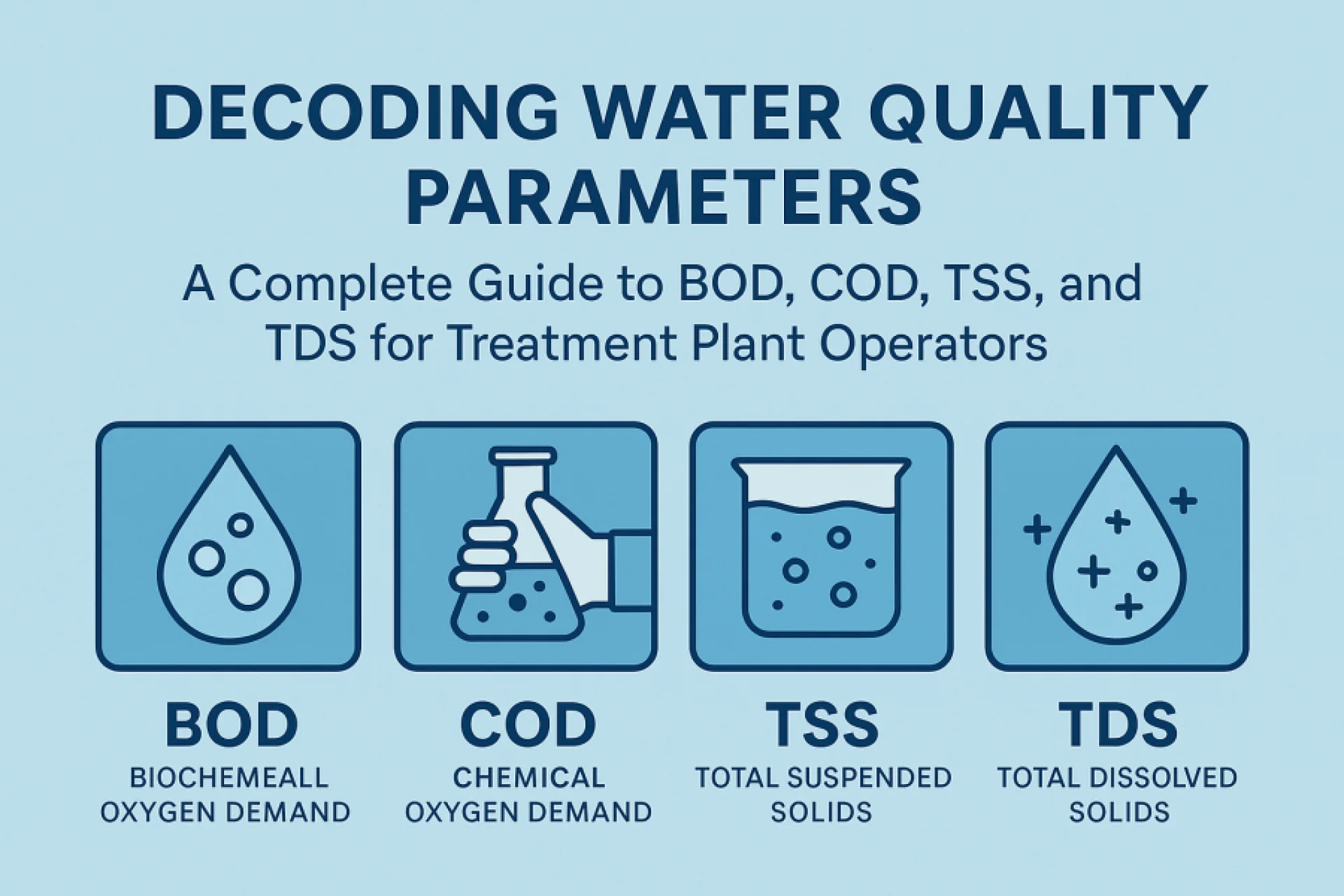ตัวชี้วัดคุณภาพน้ำเสียที่สำคัญ COD, BOD, TOC และ TOD คืออะไร?

Introduction
In wastewater treatment projects, monitoring water quality at every stage is crucial to ensure that the treated water meets discharge standards. Among various monitoring parameters, COD, BOD, TOC, and TOD are the most widely used indicators.
Various types of water quality sensors are used throughout the treatment process to continuously assess these parameters. Based on data collected from water quality analyzers, appropriate treatment methods are applied to ensure that each stage meets the required standards before proceeding to the next.
4 Key Indicators for Monitoring Wastewater Quality
What is COD (Chemical Oxygen Demand)?
COD, or Chemical Oxygen Demand, refers to the amount of oxygen required to chemically oxidize organic substances in water using a strong oxidizing agent. It is a key parameter used to assess the concentration of organic pollutants in water, typically expressed in mg/L.
High COD values indicate a higher level of organic contamination.
COD Evaluation Guidelines:
- COD = 20 mg/L: Indicates slight organic contamination; commonly found in effluents from secondary treatment.
- COD = 200 mg/L: Indicates significant contamination; requires biochemical or chemical treatment.
- COD > 500 mg/L: Common in industrial wastewater or heavily polluted sources; requires intensive treatment.
With advances in technology, COD sensors are increasingly used for wastewater monitoring because they provide fast, accurate, and environmentally friendly results, making them suitable for real-time water quality management.
What is BOD (Biochemical Oxygen Demand)?
BOD, or Biochemical Oxygen Demand, refers to the amount of oxygen consumed by microorganisms while decomposing biodegradable organic matter in water. It is a key indicator for measuring the concentration of biologically degradable organic substances in water and is typically expressed in mg/L.
To ensure consistent measurement, BOD is standardized over a 5-day period, known as 5-day BOD (BOD), and is one of the most commonly used parameters for water quality monitoring. The higher the BOD, the more organic material present, indicating higher levels of pollution.
BOD Evaluation Guidelines:
- BOD = 2 mg/L: Indicates good water quality; often found in drinking water sources.
- BOD = 20 mg/L: Typical for domestic wastewater; suitable for biological treatment.
- BOD > 100 mg/L: Indicates high organic contamination; commonly found in wastewater from food processing and brewing industries.
Difference Between COD and BOD
While COD measures the total oxygen demand to oxidize both organic and some inorganic reducing agents (e.g., sulfides, iron ions, sodium sulfite), BOD measures only the biodegradable portion of organic matter.
Some organic compounds can be fully oxidized by microbes (e.g., glucose, ethanol), some only partially (e.g., methanol), and others are non-biodegradable or even toxic (e.g., certain surfactants).
Key Point:
- COD represents the total amount of organic matter (biodegradable and non-biodegradable).
- BOD represents only the biodegradable fraction.
Thus, COD is usually higher than BOD.
BOD/COD Ratio and Biodegradability Assessment
The BOD/COD ratio indicates the biodegradability of wastewater. A higher ratio means higher potential for biological treatment.
Biodegradability Assessment Criteria:
- B/C > 0.58: Readily biodegradable
- B/C = 0.450.58: Well biodegradable
- B/C = 0.300.45: Moderately biodegradable
- B/C = 0.100.30: Poorly biodegradable
- B/C < 0.10: Not biodegradable
What is TOC (Total Organic Carbon)?
TOC, or Total Organic Carbon, refers to the total amount of carbon present in all organic compounds in a water sample. Results are expressed in mg/L of carbon (C).
Since carbon is the basic element of all organic matter, a high TOC value indicates a high concentration of organic materials in the water. Therefore, TOC is widely used as a key indicator for evaluating organic pollution in water quality analysis.
What is TOD (Total Oxygen Demand)?
TOD, or Total Oxygen Demand, indicates the total amount of oxygen (expressed in mg/L of O) needed to oxidize all reducible substances in a water sampleprimarily organic compounds.
TOD reflects the oxygen required to convert almost all organic matter into CO, HO, NO, SO, and other oxidation products through complete combustion. Compared to BOD, COD, and permanganate indices, TOD most closely aligns with theoretical oxygen demand.
Difference Between TOC and TOD
Both TOC and TOD assess organic content using combustion-based methods:
- TOC measures the carbon content in organic compounds.
- TOD measures the oxygen consumed by all reducible substances, mostly organics.
The TOD/TOC ratio can indicate the nature of organic compounds in the water. For carbon-only compounds, theoretically, one carbon atom consumes two oxygen atoms, giving an O/C ratio of 2.67.
Thus, TOD 2.67 × TOC.
If the TOD/TOC ratio exceeds 4.0, it suggests the presence of other elements such as nitrogen (N), phosphorus (P), or sulfur (S) in the organic compounds.
Summary
The table above provides a detailed comparison of the four indicators BOD, COD, TOC, and TOD highlighting their differences in definitions, principles, response time, and application scope.
BOD, COD, and TOD are all expressed in terms of oxygen demand (O), whereas TOC is expressed as the amount of organic carbon (C). For the same water sample, the typical value order is:
TOD > COD > BOD > TOC
Understanding these indicators enables wastewater treatment professionals to select appropriate monitoring and treatment methods effectively. This leads to better water quality management and contributes to long-term environmental sustainability.
This article has been created to provide knowledge on key wastewater quality indicators. For more information or consultation regarding wastewater treatment systems, please feel free to contact our experts.


